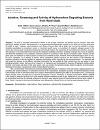Isolation, screening and activity of hydrocarbon-degrading bacteria from harsh soils
| Author | AlDisi, Zulfa |
| Author | Jaoua, Samir |
| Author | Al-Thani, Dhabia |
| Author | AlMeer, Saeed |
| Author | Zouari, Nabil |
| Available date | 2021-06-20T06:10:59Z |
| Publication Date | 2016 |
| Publication Name | World Congress on Civil, Structural, and Environmental Engineering |
| Resource | Scopus |
| ISSN | 23715294 |
| Abstract | The study of microbial communities in relation to their ecology, interaction, and genetics must be covered in Qatar with special soil, weather and water. Microorganisms of an environment never having been exposed to such factors do not have necessarily the ability to resist. However, when exposed to such factors, they are often able to adapt, that is to say the potential to acquire metabolic potentialities by recruitment vertical or horizontal specific genes, or recruitment of metabolic pathways present in the genome but not expressed. In polluted environments with oil hydrocarbons, the phenomena of horizontal/vertical transfers, mutations and adaptation to environmental stressors increase the metabolic capabilities of bacteria, including expanding their range of substrates, and allow their adaptation to new substrates. Extensive research on such fields is often focusing on genetic studies, meaning that the genes pools and expression as well as species occurrence are considered as basis. However, from the biotechnological point of view, the cell is considered, as an analogy, as factory. All its components (physical structure and the functions of the organelles and metabolic activities) are strictly regulated by regulatory machineries strictly controlled by the microenvironment. This approach will help answer the question on the different microbial communities that are available in Qatar soil and how they are unique in some biological activities. Indeed, the focus of our research is to characterize and demonstrate the diversity of biological activities within bacterial communities and strains of the same species. Here, we consider the bacterial activities related to polluting oil hydrocarbon-degrading communities, including those which are biosurfactant-producers, Here, we showed that the isolation and screening strategy affected a lot, the selection of the hydrocarbon-degrading bacteria, by combining the bacterial tolerance to hydrocarbon toxicity to the hydrocarbons degradative activities. We demonstrated that several Qatari isolates are able to shift their activity from a range of hydrocarbons to another by the effect of the nitrogen source, C/N ratio and organic nitrogen source. By application of Factorial Investigation of Strains' Potentiality to Degrade Hydrocarbons, which is original in the attempt to integrate the study of the most essential nutritional elements as well as their interactions in one experimental frame, we demonstrated diversity of nutritional requirements among the same bacterial group of Pseudomonas aeruginosa strain, isolated in Qatar. Strains' response to altered growth conditions varied substantially; although they were from the same taxonomical group. |
| Language | en |
| Publisher | Avestia Publishing |
| Subject | Biodegradation Bioremediation Diesel Hydrocarbons Petroleum Polluted soils |
| Type | Conference Paper |
Files in this item
This item appears in the following Collection(s)
-
Biological & Environmental Sciences [783 items ]
-
Central Laboratories Unit Research [86 items ]


